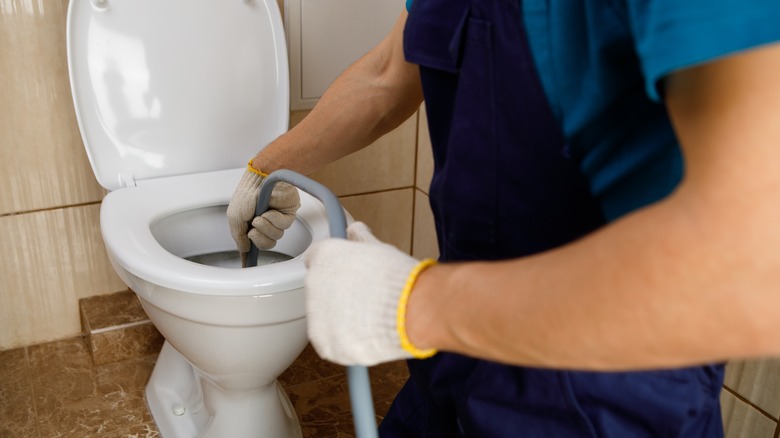A Plumbing Vent Might Be The Cause Of Your Clogged Toilet - Here's What That Means
Being a homeowner comes with numerous responsibilities and challenges, and among the most daunting can be plumbing issues, particularly a persistently clogged toilet. While many quickly blame their toilet or the plumbing system, the culprit may be less obvious – the plumbing vent. If you've been dealing with a clogged toilet, it's worth exploring whether the vent is at the cause. Vents can get obstructed for various reasons — an accumulation of leaves, debris, or even a buildup of frost or snow in colder climates. When this happens, the disruption to the air pressure in your plumbing system can lead to persistent toilet clogs.
Often overlooked, the plumbing vent — AKA a vent stack — serves crucial functions in maintaining your home's sanitation and drainage. When functioning correctly, it also maintains adequate air pressure in your home's pipes, which is necessary for an operational toilet. You may employ various methods to fix persistent clogs, such as plungers, drain snakes, or commercial drain cleaners. While these solutions may appear to work temporarily, the problem will recur if the root cause is a blocked vent. Luckily, this common issue is fairly straightforward to diagnose and address.
Understanding the role of plumbing vents
Your home's plumbing system is more complex than just the visible pipes and drains. Vent stacks are hidden within the walls and roof and serve two crucial purposes. First, they allow wastewater and sewer gasses to exit the home. Without this vent, these gases would seep out through drains, filling your home with odors. They also allow clean air into the plumbing system to help water flow smoothly through the pipes. Imagine drinking a beverage with a straw. If you put your finger over the top of the straw, the liquid stays put even when you stop sucking. But when you remove your finger, air enters the straw, and the liquid flows freely. Similarly, a plumbing vent allows air to enter and equalize pressure in the pipes. Without this air, water would not flow quickly, leading to slow or clogged drains.
So, how does a clogged vent stack lead to toilet problems? Just like how covering the top of a straw hinders liquid flow, a blocked vent stack can hinder water flow in your pipes, leading to slow drains or frequent toilet clogs. When the vent is clogged, it can create a vacuum in the pipes. As a result, when you flush the toilet, the water doesn't have enough force to move with the waste through the pipes. Instead, it struggles against the vacuum effect, resulting in poor flushing or back-ups.
Identifying and clearing a blocked vent stack
A blocked vent stack can be tricky to identify because it's not as noticeable as a clogged drain. This is because a vent stack is typically out of sight. However, there are signs that you can look for to identify if your vent stack might be blocked. One sign is the occurrence of unusual gurgling sounds from your drains. Other strong indicators of a blocked vent include slow drainage and a persistent sewer odor in your home. If the vent is blocked, the sewer gases that are supposed to escape through the vent may end up inside your home, creating an unpleasant smell.
To fix a blocked vent stack, you'll likely need access to your roof. It's critical to prioritize safety when doing this — use appropriate gear like non-slip shoes and harnesses, and always have someone around to assist or call for help if needed. If you're uncomfortable with heights, it's best to hire a professional. Once you're at the vent, use a flashlight to conduct an initial inspection for visible blockages. If you see obstructions, a plumbing snake can be invaluable for clearing them. Alternatively, using a garden hose to flush the vent with water can often dislodge the blockage if the blockage is stubborn.


